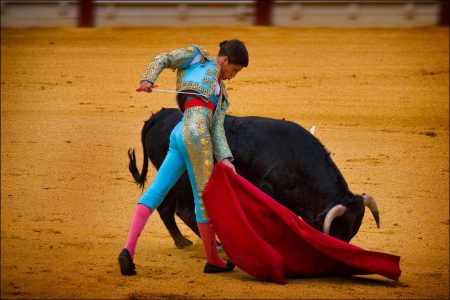Spanish-style bullfighting is called a corrida de toros (literally a “running of bulls”), tauromaquia or fiesta and is practiced in Spain, where it originates, Mexico, Colombia, Ecuador, Venezuela, Peru, as well as in parts of Southern France and Portugal.
In traditional corrida, three toreros, also called matadores or, in French, toréadors, each fight two out of a total of six fighting bulls, each of which is at least four years old and weighs up to about 600 kg or 1,300 lb (with a minimum weight limit of 460 kg or 1,010 lb for the bullrings of the first degree). Bullfighting season in Spain runs from March to October.
Each matador has six assistants — two picadores (“lancers”) mounted on horseback, three banderilleros (“flagmen”), and a mozo de espada (“sword servant”). Collectively they comprise a cuadrilla or team of bullfighters. The crew also includes an ayuda (aide to sword servant) and subalternos (subordinates) including at least two peones (pages, singular peón).
Anti-Bullfighting Movement
Activisim against Bullfighting has existed in Spain since the beginning of the Early nineteenth century, when a group of intellectuals, pertaining to the Generation of 98, embarked on a dual crusade against the popularity of Bullfighting and Flamenco music, dismissing them as “non-european” elements of Spanish culture which were to blame for the country’s social and economic backwardness. More recently, bullfighting has come under increasing attack from the far-left citing concern for animal welfare.
Perhaps more significantly, separatist and nationalist sentiment in Catalonia has played a key role in the region wide ban of a practice which is strongly associated to Spanish national identity. Animal welfare concerns are perhaps the prime driver of anti-bullfighting outside Spain although rejection of traditionalism and criollo elitism may also play a role in Latin America, explaining why such activism is so closely associated to leftist or far-leftist positions in Mexico, Ecuador and Colombia.
Animal rights activists claim bullfighting is a cruel or barbarous blood sport, in which the bull suffers severe stress and a slow, torturous death. A number of animal rights or animal welfare activist groups such as Antitauromaquia and StopOurShame undertake anti-bullfighting actions in Spain and other countries.
Others, such as author Alexander Fiske-Harrison who trained as a bullfighter to research for a book on the subject, have argued that there are mitigating circumstances to this: “In terms of animal welfare, the fighting bull lives four to six years whereas the meat cow lives one to two. What is more, it doesn’t just live in the sense of existing, it lives a full and natural life. Those years are spent free, roaming in the dehesa, the lightly wooded natural pastureland which is the residue of the ancient forests of Spain.
It is a rural idyll, although with the modern additions of full veterinary care and an absence of predators big enough to threaten evolution’s answer to a main battle tank.” Other arguments include those to the effect that the death of animals in slaughterhouses is often much worse than the death in the ring, and that both types of animal die for entertainment since humans do not need to consume meat, eating it instead for taste (bulls enter the food chain after the bullfight).
Visits: 108



